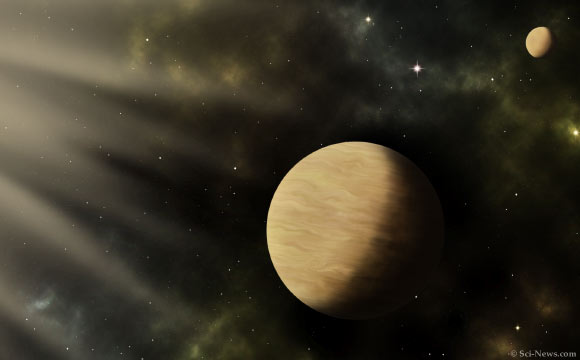To facilitate studies of exo-Venus candidates, astronomers from the University of California, Riverside, the University of California, Santa Cruz, Brown University and Southwest Research Institute provide a catalog of all confirmed rocky planets in the so-called Venus zone, including transiting and non-transiting worlds.

An artist’s impression of two Venus-zone exoplanets around the nearby red dwarf star TOI-1266. Image credit: Sci.News.
University of California, Riverside Ph.D. student Colby Ostberg and colleagues began with 317 known rocky exoplanets in the Venus zone, a range of stellar distances where a planet with an initial Earth-like atmosphere could experience a runaway greenhouse effect that transforms it into a Venus-like atmosphere.
The astronomers whittled the list down to the five most likely to resemble Venus in terms of their radii, masses, densities, the shapes of their orbits, and perhaps most significantly, distances from their stars.
They also ranked the most Venus-like planets in terms of the brightness of the stars they orbit, which increases the likelihood that the NASA/ESA/CSA James Webb Space Telescope would get more informative signals regarding the composition of their atmospheres.
Today’s Venus floats in a nest of sulfuric acid clouds, has no water, and features surface temperatures of up to 475 degrees Celsius (900 degrees Fahrenheit) — hot enough to melt lead.
Using Webb to observe these possible Venus analogs, or exo-Venuses, the astronomers hope to learn if things were ever different for our Venus.
“One thing we wonder is if Venus could once have been habitable,” Ostberg said.
“To confirm this, we want to look at the coolest of the planets in the outer edge of the Venus zone, where they get less energy from their stars.”
Finding a planet similar to Venus in terms of planet mass is also important because mass affects how long a planet is able to maintain an active interior, with the movement of rocky plates across its outer shell known as plate tectonics.
“Venus has 20% less mass than Earth, and as a result, scientists believe there may not be any tectonic activity there,” Ostberg said.
“Therefore, Venus has a hard time taking carbon out of its atmosphere. The planet just can’t get rid of it.”
Another aspect of an active planet interior is volcanic activity, and evidence uncovered just this month suggests Venus still has active volcanoes.
“The large number of Venus analogs identified in our paper will allow us to test if such volcanic activity is the norm amongst similar planets, or not,” said University of California, Riverside astrophysicist Stephen Kane.
The authors are proposing the planets identified in the paper as targets for the Webb telescope in 2024.
The observations may reveal biosignature gases in the atmosphere of an exo-Venus, such as methane, methyl bromide or nitrous oxide, which could signal the presence of life.
“Detecting those molecules on an exo-Venus would show that habitable worlds can exist in the Venus zone and strengthen the possibility of a temperate period in Venus’ past,” Dr. Ostberg said.
This research is described in a paper published in the March 21, 2023 issue of the Astronomical Journal.
_____
Colby Ostberg et al. 2023. The Demographics of Terrestrial Planets in the Venus Zone. AJ 165, 168; doi: 10.3847/1538-3881/acbfaf







